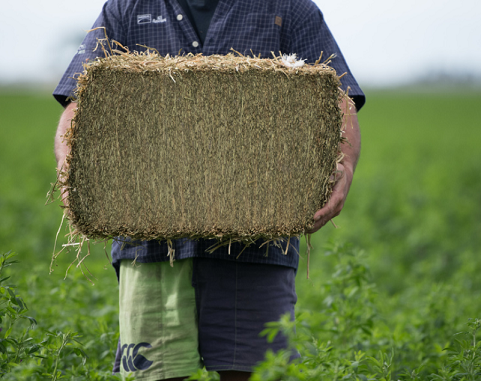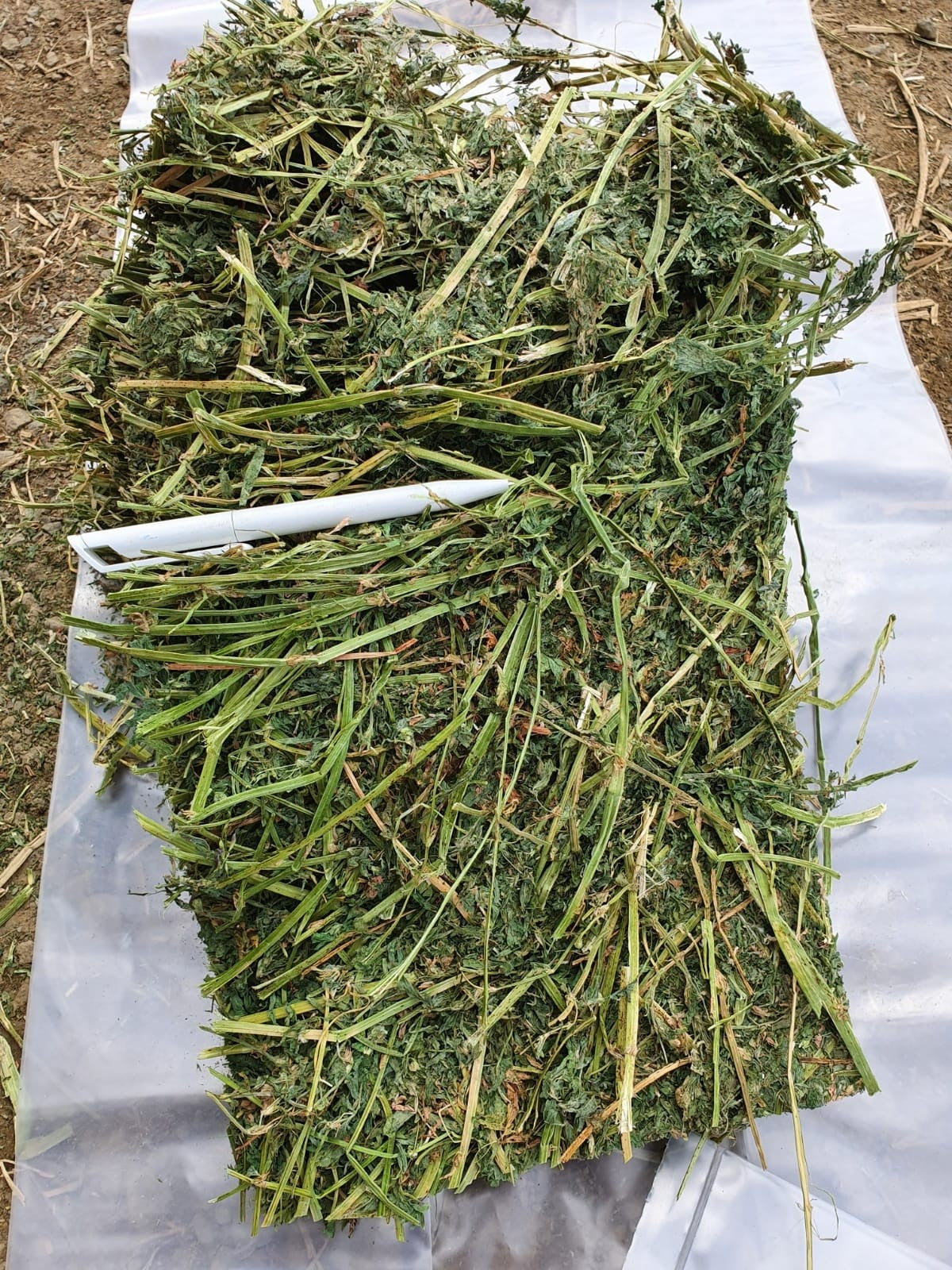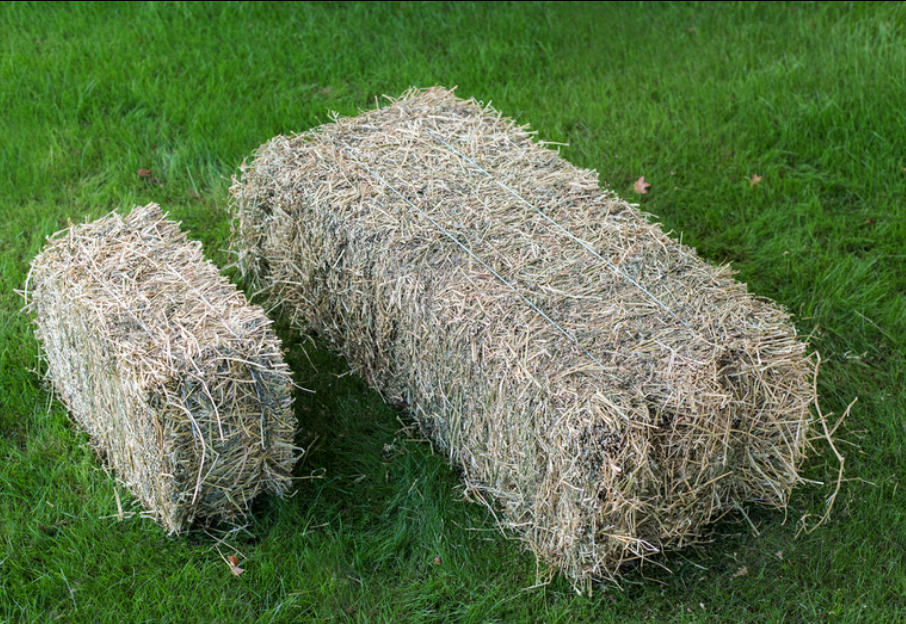- Bale size – 50cm
- Bale weight – 20kg approx.
Nutritional Analysis*
- DM 85-90%
- ME 10-11.5%
- CP 20-24%
Storage
- Must be stored indoors in a cool dry space
*Nutritional Value is based on a standard sample, this may vary between batches
SEVERAL FACTORS SHOULD BE CONSIDERED WHEN DECIDING WHAT TYPE OF HAY TO FEED. MOST IMPORTANT IS CLEANLINESS, BUT NUTRIENT VALUE AND THE TYPE OF HORSE BEING FED SHOULD ALSO BE CONSIDERED.
Many different types of hay are acceptable in horse feeding programs. Local availability often influences the popularity of a particular variety of hay in a geographical area.
The Best Hay Is Clean Hay
Without a doubt the best hay for horses is clean hay. Hay that is moldy or dusty should not be fed to horses, even when the amount of mold or dust appears to be minor. Any hay (lucerne, grass, clover) that contains dust or mold can inflame the respiratory tract and impair breathing ability.
Factors Affecting the Nutrient Value of Hay
When the price per ton of various hays is similar, lucerne is usually the best value because it has more nutrients. In addition, because lucerne tends to be more palatable than other hay types, horses will usually waste less.
The biggest variable affecting nutrient content within a type of hay is the stage of maturity at harvest. Very early maturity hay often has a soft texture, is very leafy, and has a high nutrient density and palatability. Plants harvested in early maturity are cut soon after the seed heads emerge (grasses) or before the plant begins to bloom (legumes like lucerne or clover). Plants harvested in late maturity will have coarse, thick stems and less leaf than plants harvested in early maturity. The older the plant is at the time of harvest, the lower the nutrient value and the palatability. The best way to evaluate nutrient value is to have a chemical analysis performed
Matching Hay Type to Horse Type
Not all horses have the same nutrient needs, so naturally not all horses have the same hay needs. The best hay for any horse depends on the needs of that horse. Horses used for light recreational riding have relatively low nutrient requirements compared to growing horses, lactating mares, and performance horses. Late or mid-maturity lucerne or mid-maturity grass hays are often very suitable for horses with low nutrient requirements (Table 1). In fact, mid-to-late maturity hay is usually a more desirable feed source for horses with lower nutrient requirements because the horses can eat more hay to satisfy their appetites without getting too fat.
Early-maturity lucerne hay is usually not the best hay choice for horses with low nutrient requirements. When early-maturity lucerne hay is fed to horses with low nutrient requirements, less hay is necessary to meet nutrient requirements. This may seem like an advantage because less hay is used each day. However, restricting hay intake can have some negative effects. If a horse’s appetite is not satisfied, it may be inclined to redirect chewing needs to other objects such as fences, stalls, or trees. Alternatively, if the intake of very nutritious hay is not restricted, excess nutrient intake and weight gain will occur.
Early bloom lucerne hay is not usually the best choice for horses with low nutrient requirements, but it is an excellent choice for growing horses and lactating mares.
Many horses have high nutrient needs; consequently, early maturity lucerne hay does have a place in horse feeding programs. Early-maturity lucerne is an excellent hay choice for growing horses and lactating mares. Early-maturity hays are more palatable than late-maturity hays, so they are useful for horses with poor appetites.
Is Hay a Nutritionally Balanced Diet?
For horses with low nutrient requirements, mid-maturity hay can meet most of the nutrient needs. Hay is low in sodium and chloride, so a salt block is necessary. Some horses may need a minimal amount of grain to maintain body weight if late maturity hay is fed. Lactating mares, growing horses, and horses in moderate to heavy work usually cannot eat enough hay to meet their nutrient requirements and will almost always need some grain in their diets.
Table 1: Effect of stage of maturity and hay variety on the amount of hay and grain required by horses at maintenance and lactation.
| Type of Hay | Amount of hay and grain required by an 500kg horse at maintenance per day | Amount of hay and grain required by an 500kg mare in lactation per day |
| Pre-Bloom Lucerne | 6.5 – 7.5 kg of hay, no grain | 8 – 9 kg of hay and 3 – 4 kg of grain |
| Late Bloom Lucerne | 10 – 11 kg of hay, no grain | 11 – 13kg of hay and 3 – 4 kg of grain;
OR 8 to 9 kg of hay and 4.5 to 5.5 kg of grain |
| Mid-Maturity Lucerne-Grass Hay Mix | 7 – 9 kg of hay, no grain
|
10 – 11 kg of hay, 3 – 4.5 kg of grain |
The type of hay used will affect the amount and type of grain that is needed by horses (Table 1). When early maturity hays are fed, the amount of grain in the diet can often be reduced. One of the big advantages of lucerne is the amount of protein it provides. When lucerne hay is fed, the amount of crude protein provided by the grain can be reduced. If lucerne is fed, the concentration of protein in the grain can be reduced to 12%. Lower protein grain mixes cost less than high-protein grain mixes.
Lucerne is also high in calcium, which makes it better to feed with plain grains such as maize or oats, which are deficient in calcium. If young horses are fed a grass hay/oats combination, the diet will probably be deficient in calcium and several other minerals. If lucerne hay is substituted for the grass hay, the calcium requirement will usually be met.
Buy Good Hay and Feed More of It!
High grain intakes have been implicated as a risk factor in equine colic, which is a good reason to feed as much hay as possible. Diets with low levels of hay have also been related to an increased incidence of stall vices such as cribbing and wood chewing. In addition, the most economical feeding programs maximize forage intake and then add grain or other feeds to meet any unfulfilled requirements. The actual amount of hay that any horse will consume depends on its body weight and physiologic class (growing, lactating, working) and the type of hay available. Table 1 gives some examples of hay intakes expected under different conditions. It is rarely practical to weigh hay for every horse every day, so the best management practice is to feed enough hay so there is always a little bit left.
Is Lucerne too Rich for My Horse?
While lucerne hay is a more nutrient-rich feed than most other hays, it is not any richer than many other feeds commonly used for horses. For example, the horse’s most natural feedstuff, good quality pasture, is often higher in calories and protein than lucerne hay. Leafy, rapidly growing cool-season grass pasture contains over 20% crude protein on a dry matter basis. By comparison, mid-maturity lucerne hay will contain 16 to 18% crude protein on a dry matter basis. For horses that are relatively inactive and are not growing or lactating, mid- to late maturity lucerne hay will be a more appropriate feed than early-maturity lucerne. Lucerne is a good feed for lactating mares and growing horses because of its high nutrient value.
Source: adapted from “Choosing hay for horses”. L. Lawrence, R. Coleman & J. Henning, Univ. of Kentucky





